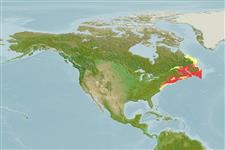>
Perciformes/Cottoidei (Sculpins) >
Agonidae (Poachers) > Hemitripterinae
Etymology: Hemitripterus: Greek, hemi = half + Greek, tres, tria = three + Greek, pteron = wing, fin (Ref. 45335).
More on author: Gmelin.
Environment: milieu / climate zone / depth range / distribution range
Écologie
marin démersal; profondeur 2 - 180 m. Temperate; ? - 16°C (Ref. 27549); 58°N - 36°N, 76°W - 50°W
Northwest Atlantic: Labrador in Canada to Chesapeake Bay in USA.
Taille / Poids / Âge
Maturity: Lm ? range ? - ? cm
Max length : 68.0 cm TL mâle / non sexé; (Ref. 49746); poids max. publié: 3.2 kg (Ref. 7251)
Inhabit rocky or hard bottom and is a voracious eater. Food includes crustaceans, mollusks, sea urchins, fishes such as herring, sand lance and silver hake, and any bottom invertebrates that are available. When taken out of the water the belly becomes inflated so that when returned to the water they are unable to submerge. Adults attach their eggs near the base of a sponge to use as a spawning bed (Ref. 34819, 41075).
Life cycle and mating behavior
Maturité | Reproduction | Frai | Œufs | Fécondité | Larves
Adults attach their eggs near the base of a sponge to use as a spawning bed (Ref. 34819, 41075).
Robins, C.R. and G.C. Ray, 1986. A field guide to Atlantic coast fishes of North America. Houghton Mifflin Company, Boston, U.S.A. 354 p. (Ref. 7251)
Statut dans la liste rouge de l'IUCN (Ref. 130435: Version 2024-1)
Menace pour l'homme
Harmless
Utilisations par l'homme
Pêche sportive: oui; appât: occasionally
Outils
Articles particuliers
Télécharger en XML
Sources Internet
Estimates based on models
Preferred temperature (Ref.
123201): 0.5 - 10.2, mean 3.8 °C (based on 130 cells).
Phylogenetic diversity index (Ref.
82804): PD
50 = 0.6289 [Uniqueness, from 0.5 = low to 2.0 = high].
Bayesian length-weight: a=0.00794 (0.00578 - 0.01091), b=3.19 (3.10 - 3.28), in cm total length, based on LWR estimates for this species (Ref.
93245).
Niveau trophique (Ref.
69278): 4.5 ±0.5 se; based on diet studies.
Résilience (Ref.
120179): Très faible, temps minimum de doublement de population supérieur à 14 ans (Preliminary K or Fecundity.).
Fishing Vulnerability (Ref.
59153): Moderate to high vulnerability (47 of 100).
Nutrients (Ref.
124155): Calcium = 32.1 [17.3, 64.8] mg/100g; Iron = 0.341 [0.174, 0.650] mg/100g; Protein = 17.2 [15.9, 18.5] %; Omega3 = 0.575 [0.254, 1.525] g/100g; Selenium = 17.2 [8.4, 40.8] μg/100g; VitaminA = 24.2 [7.4, 79.7] μg/100g; Zinc = 0.423 [0.300, 0.618] mg/100g (wet weight);
